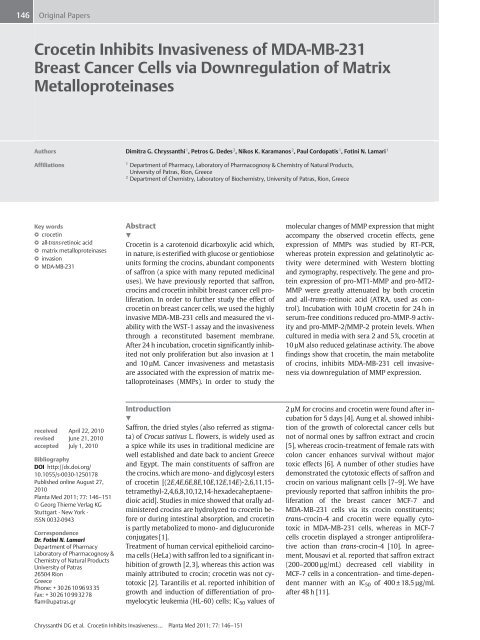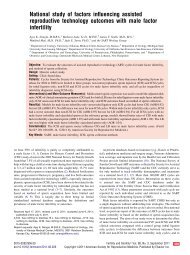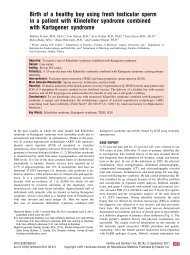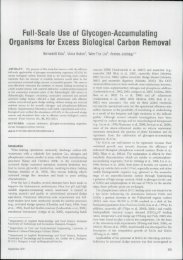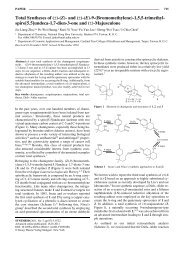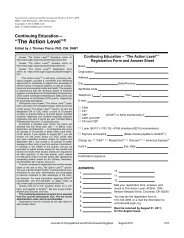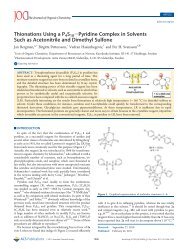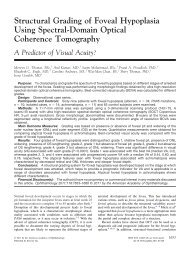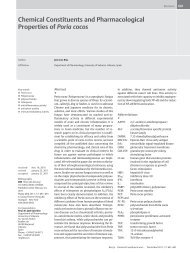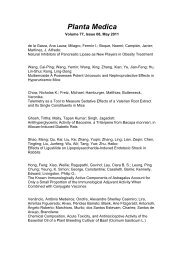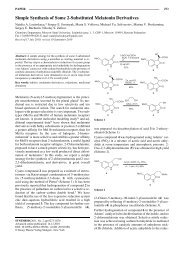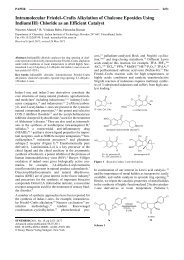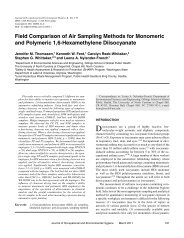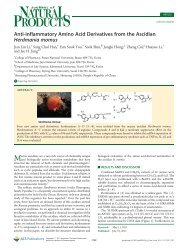Crocetin Inhibits Invasiveness of MDA‑MB‑231 Breast Cancer Cells ...
Crocetin Inhibits Invasiveness of MDA‑MB‑231 Breast Cancer Cells ...
Crocetin Inhibits Invasiveness of MDA‑MB‑231 Breast Cancer Cells ...
Create successful ePaper yourself
Turn your PDF publications into a flip-book with our unique Google optimized e-Paper software.
146<br />
Original Papers<br />
<strong>Crocetin</strong> <strong>Inhibits</strong> <strong>Invasiveness</strong> <strong>of</strong> <strong>MDA‑MB‑231</strong><br />
<strong>Breast</strong> <strong>Cancer</strong> <strong>Cells</strong> via Downregulation <strong>of</strong> Matrix<br />
Metalloproteinases<br />
Authors Dimitra G. Chryssanthi 1 , Petros G. Dedes 2 , Nikos K. Karamanos 2 , Paul Cordopatis 1 , Fotini N. Lamari 1<br />
Affiliations<br />
Key words<br />
l " crocetin<br />
l " all‑trans‑retinoic acid<br />
l " matrix metalloproteinases<br />
l " invasion<br />
l " <strong>MDA‑MB‑231</strong><br />
received April 22, 2010<br />
revised June 21, 2010<br />
accepted July 1, 2010<br />
Bibliography<br />
DOI http://dx.doi.org/<br />
10.1055/s-0030-1250178<br />
Published online August 27,<br />
2010<br />
Planta Med 2011; 77: 146–151<br />
© Georg Thieme Verlag KG<br />
Stuttgart · New York ·<br />
ISSN 0032‑0943<br />
Correspondence<br />
Dr. Fotini N. Lamari<br />
Department <strong>of</strong> Pharmacy<br />
Laboratory <strong>of</strong> Pharmacognosy &<br />
Chemistry <strong>of</strong> Natural Products<br />
University <strong>of</strong> Patras<br />
26504 Rion<br />
Greece<br />
Phone: + 30 2610 9693 35<br />
Fax: + 3026 10 9932 78<br />
flam@upatras.gr<br />
1 Department <strong>of</strong> Pharmacy, Laboratory <strong>of</strong> Pharmacognosy & Chemistry <strong>of</strong> Natural Products,<br />
University <strong>of</strong> Patras, Rion, Greece<br />
2 Department <strong>of</strong> Chemistry, Laboratory <strong>of</strong> Biochemistry, University <strong>of</strong> Patras, Rion, Greece<br />
Abstract<br />
!<br />
<strong>Crocetin</strong> is a carotenoid dicarboxylic acid which,<br />
in nature, is esterified with glucose or gentiobiose<br />
units forming the crocins, abundant components<br />
<strong>of</strong> saffron (a spice with many reputed medicinal<br />
uses). We have previously reported that saffron,<br />
crocins and crocetin inhibit breast cancer cell proliferation.<br />
In order to further study the effect <strong>of</strong><br />
crocetin on breast cancer cells, we used the highly<br />
invasive <strong>MDA‑MB‑231</strong> cells and measured the viability<br />
with the WST-1 assay and the invasiveness<br />
through a reconstituted basement membrane.<br />
After 24 h incubation, crocetin significantly inhibited<br />
not only proliferation but also invasion at 1<br />
and 10 µM. <strong>Cancer</strong> invasiveness and metastasis<br />
are associated with the expression <strong>of</strong> matrix metalloproteinases<br />
(MMPs). In order to study the<br />
Introduction<br />
!<br />
Saffron, the dried styles (also referred as stigmata)<br />
<strong>of</strong> Crocus sativus L. flowers, is widely used as<br />
a spice while its uses in traditional medicine are<br />
well established and date back to ancient Greece<br />
and Egypt. The main constituents <strong>of</strong> saffron are<br />
the crocins, which are mono- and diglycosyl esters<br />
<strong>of</strong> crocetin [(2E,4E,6E,8E,10E,12E,14E)-2,6,11,15tetramethyl-2,4,6,8,10,12,14-hexadecaheptaenedioic<br />
acid]. Studies in mice showed that orally administered<br />
crocins are hydrolyzed to crocetin before<br />
or during intestinal absorption, and crocetin<br />
is partly metabolized to mono- and diglucuronide<br />
conjugates [1].<br />
Treatment <strong>of</strong> human cervical epithelioid carcinoma<br />
cells (HeLa) with saffron led to a significant inhibition<br />
<strong>of</strong> growth [2, 3], whereas this action was<br />
mainly attributed to crocin; crocetin was not cytotoxic<br />
[2]. Tarantilis et al. reported inhibition <strong>of</strong><br />
growth and induction <strong>of</strong> differentiation <strong>of</strong> promyelocytic<br />
leukemia (HL-60) cells; IC50 values <strong>of</strong><br />
Chryssanthi DG et al. <strong>Crocetin</strong> <strong>Inhibits</strong> <strong>Invasiveness</strong>… Planta Med 2011; 77: 146–151<br />
molecular changes <strong>of</strong> MMP expression that might<br />
accompany the observed crocetin effects, gene<br />
expression <strong>of</strong> MMPs was studied by RT‑PCR,<br />
whereas protein expression and gelatinolytic activity<br />
were determined with Western blotting<br />
and zymography, respectively. The gene and protein<br />
expression <strong>of</strong> pro-MT1-MMP and pro-MT2-<br />
MMP were greatly attenuated by both crocetin<br />
and all-trans-retinoic acid (ATRA, used as control).<br />
Incubation with 10 µM crocetin for 24 h in<br />
serum-free conditions reduced pro-MMP‑9activity<br />
and pro-MMP‑2/MMP‑2 protein levels. When<br />
cultured in media with sera 2 and 5%, crocetin at<br />
10 μΜ also reduced gelatinase activity. The above<br />
findings show that crocetin, the main metabolite<br />
<strong>of</strong> crocins, inhibits <strong>MDA‑MB‑231</strong> cell invasiveness<br />
via downregulation <strong>of</strong> MMP expression.<br />
2 µM for crocins and crocetin were found after incubation<br />
for 5 days [4]. Aung et al. showed inhibition<br />
<strong>of</strong> the growth <strong>of</strong> colorectal cancer cells but<br />
not <strong>of</strong> normal ones by saffron extract and crocin<br />
[5], whereas crocin-treatment <strong>of</strong> female rats with<br />
colon cancer enhances survival without major<br />
toxic effects [6]. A number <strong>of</strong> other studies have<br />
demonstrated the cytotoxic effects <strong>of</strong> saffron and<br />
crocin on various malignant cells [7–9]. We have<br />
previously reported that saffron inhibits the proliferation<br />
<strong>of</strong> the breast cancer MCF-7 and<br />
<strong>MDA‑MB‑231</strong> cells via its crocin constituents;<br />
trans-crocin-4 and crocetin were equally cytotoxic<br />
in <strong>MDA‑MB‑231</strong> cells, whereas in MCF-7<br />
cells crocetin displayed a stronger antiproliferative<br />
action than trans-crocin-4 [10]. In agreement,<br />
Mousavi et al. reported that saffron extract<br />
(200–2000 µg/mL) decreased cell viability in<br />
MCF-7 cells in a concentration- and time-dependent<br />
manner with an IC50 <strong>of</strong> 400 ± 18.5 µg/mL<br />
after 48 h [11].
<strong>Cancer</strong> invasion and metastasis have been associated with overexpression<br />
<strong>of</strong> matrix metalloproteinases (MMPs) by tumor and<br />
stromal cells [12]. MMPs, which are synthesized as zymogens,<br />
are a family <strong>of</strong> structurally and functionally related endoproteinases<br />
that are involved in many physiological and pathological<br />
processes, including the host immune response and the early<br />
steps <strong>of</strong> tumor evolution [12, 13]. Kousidou et al. reported that<br />
MMP-9 and MT2-MMP are highly expressed in all breast epithelial<br />
cancer cells as compared to normal mammary cells, whereas<br />
the expression <strong>of</strong> MT2-MMP (MMP-15) may well be associated<br />
with the malignant transformation <strong>of</strong> breast cells [14].<br />
The aim <strong>of</strong> this study was to investigate the effect <strong>of</strong> the aglycon<br />
and main metabolite <strong>of</strong> crocins, i.e., crocetin on proliferation and<br />
invasiveness <strong>of</strong> <strong>MDA‑MB‑231</strong> cells (human breast adenocarcinoma,<br />
ER-negative). The <strong>MDA‑MB‑231</strong> cell line was selected since it<br />
has a high invasive potential [15]. In an attempt to find out the<br />
mechanism by which invasiveness is attenuated, the effect <strong>of</strong> crocetin<br />
on the expression pattern <strong>of</strong> the main metalloproteinases in<br />
<strong>MDA‑MB‑231</strong> cells, i.e., MMP-2,‑9,‑14 (MT1) and ‑15 (MT2), was<br />
examined. In all the experiments, all-trans-retinoic acid (ATRA)<br />
was used as a control. ATRA, a representative <strong>of</strong> the retinoid family,<br />
has been shown to inhibit the invasion <strong>of</strong> <strong>MDA‑MB‑231</strong> cells<br />
and to decrease gelatinolytic and collagenolytic (MMP-1 expression)<br />
activity [16, 17].<br />
Materials and Methods<br />
!<br />
Chemicals and materials<br />
The <strong>MDA‑MB‑231</strong> cell line was obtained from the American Type<br />
Culture Collection (ATCC) and Dulbeccoʼs minimal essential medium<br />
(DMEM) was from Biochrom KG Seromed ® . Fetal bovine serum<br />
(FBS), L-glutamine, sodium pyruvate, sodium bicarbonate,<br />
nonessential amino acids, and antimicrobial agents were also<br />
from Biochrom KG Seromed ® . Bovine insulin, D-glucose and agarose<br />
were purchased from Sigma-Aldrich. All-trans-retinoic acid<br />
(≥ 98% purity) was also purchased from Sigma-Aldrich (R2625)<br />
and stock solutions <strong>of</strong> ATRA were prepared in DMSO at a starting<br />
concentration <strong>of</strong> 0.2 M. All reagents were <strong>of</strong> analytical grade.<br />
Commercially available saffron (styles <strong>of</strong> C. sativus) was kindly<br />
provided by the Cooperative de Safran (Krokos Kozanise). The<br />
plant material was identified by Pr<strong>of</strong>essor Gregorios Iatrou, Department<br />
<strong>of</strong> Biology, University <strong>of</strong> Patras, Greece.<br />
<strong>Crocetin</strong> preparation<br />
<strong>Crocetin</strong> was prepared by saponification <strong>of</strong> saffron aqueous extract<br />
as previously described [1, 10]. In brief, the extract was hydrolyzed<br />
with 10% w/v sodium hydroxide at room temperature<br />
for 2 h. The solution was then acidified with 1 N H2SO4 and the<br />
formed precipitate was washed twice with water and then with<br />
methanol. <strong>Crocetin</strong> was then crystallized with dimethylformamide<br />
and dried under vacuum. <strong>Crocetin</strong> was further purified<br />
with semipreparative HPLC on a Supelcosil C18 (5 µm,<br />
25 cm × 4.6 mm, Sigma-Aldrich) column. Elution was performed<br />
with a gradient <strong>of</strong> methanol (40–100%) for 40 min at a flow rate<br />
<strong>of</strong> 1.5 mL/min. The purity and identity <strong>of</strong> crocetin was studied<br />
with HPLC, ESI‑MS, NMR, UV‑vis and IR spectroscopy. The stock<br />
solution <strong>of</strong> crocetin (purity > 98%) was prepared in DMSO at a<br />
starting concentration <strong>of</strong> 1 M.<br />
Original Papers<br />
Cell culture<br />
<strong>Cells</strong> were cultured as monolayers at 37 °C in a humidified atmosphere<br />
<strong>of</strong> 5% (v/v) CO2 and 95% air and in DMEM supplemented<br />
with 10% FBS, 2 mM L-glutamine, 1.0 mM sodium pyruvate, 1.5 g/<br />
L sodium bicarbonate, 0.1 mM nonessential amino acids, 100 µg/<br />
mL <strong>of</strong> insulin and a cocktail <strong>of</strong> antimicrobial agents (100 IU/mL<br />
penicillin, 100 µg/mL streptomycin, 10 µg/mL gentamycin and<br />
2.5 µg/mL amphoterecin B). For cell viability assays, cells were<br />
seeded at an initial concentration <strong>of</strong> 5000 cells/well in 24-well<br />
tissue culture plates and incubated in serum-free medium with<br />
crocetin and ATRA at the concentrations <strong>of</strong> 1 μΜ and 10 μΜ for<br />
24 h. Control cells were cultured in medium containing DMSO at<br />
the same percentage (maximum 0.1% v/v) as in the treated cells.<br />
Cell viability was assessed using the WST-1 reagent from Invitrogen.<br />
Each experiment was performed in triplicate and performed<br />
at least three times.<br />
Cell invasion assay<br />
<strong>Cells</strong> were grown in plastic tissue culture flasks in serum-containing<br />
media until they reached approximately 60–65% confluency.<br />
<strong>Cells</strong> were then incubated for 24 h in serum-free medium<br />
with or without the tested compounds. <strong>Invasiveness</strong> was measured<br />
using the CHEMICON Cell Invasion Assay Kit ECM 550<br />
(Chemicon ® International, Inc.). After 24 h pretreatment with<br />
the tested compounds, cells were cultured in serum-free media<br />
containing the tested compounds in microplate inserts with a<br />
polycarbonate membrane, over which the reconstituted matrix<br />
was dried. These inserts were dipped in serum-containing media<br />
in 24-well tissue culture plates and incubated for 24 h. Invasive<br />
cells migrate through the ECM layer and cling to the bottom <strong>of</strong><br />
the polycarbonate membrane. After the non-invading cells were<br />
carefully removed, invading cells were stained, photographed<br />
and quantitated through dilution in acetic acid 10%. Absorbance<br />
was measured at 560 nm.<br />
Culture conditions for studying the expression <strong>of</strong> MMPs<br />
<strong>Cells</strong> were grown in 75-cm 2 plastic tissue culture flasks in serumcontaining<br />
media until they reached approximately 60–65% confluency.<br />
<strong>Cells</strong> were then incubated for 24 h in serum-free medium<br />
with the tested compounds or with medium containing<br />
DMSO at the same percentage as in the treated cells. Total cellular<br />
RNA was isolated after cell lysis with guanidium isothiocyanate<br />
using the SV total RNA isolation system (Promega GmbH). The<br />
expression <strong>of</strong> mRNAs encoded for MMPs [‑2, ‑9, MT1-MMP<br />
(MMP-14), MT2-MMP (MMP-15)] was examined by RT‑PCR.<br />
RT‑PCR conditions<br />
Reverse transcription <strong>of</strong> RNA was performed using the Qiagen ®<br />
OneStep RT‑PCR kit (Qiagen GmbH), on a Perkin-Elmer 2400<br />
Gene AMP PCR System. The sequences <strong>of</strong> the primers and the<br />
respective conditions used were for MMP-2: upstream 5′-<br />
ATGCTTCCAAACTTCACGCTCT‑3′ downstream 5′-CACAGCCAAC-<br />
TACGATGACGA‑3′ (tann = 57 °C, 828 bp); MMP-9: upstream 5′-<br />
GGCCCTTCTACGGCCACT‑3′ downstream 5′-TTCATGACCGCTAA-<br />
GAGAC‑3′ (tann = 57 °C, 515 bp); MMP-14: upstream 5′-<br />
CGCTACGCCATCCAGGGTCTCAAA‑3′ downstream 5′-CGGTCAT-<br />
CATCGGGCAGCACAAAA‑3′ (tann = 62 °C, 497 bp); MMP-15: upstream:<br />
5′-ACAACCACCATCTGACCTTTAGCA‑3′ downstream<br />
5′-AGCTTGAAGTTGTCAACGTCCTTC‑3′ (tann = 62 °C, 454 bp);<br />
GAPDH: upstream 5′-ACATCATCCCTGCCTCTACTGG‑3′ downstream<br />
5′-AGTGGGTGTCGCTGTTGAAGTC (261 bp).<br />
Chryssanthi DG et al. <strong>Crocetin</strong> <strong>Inhibits</strong> <strong>Invasiveness</strong>… Planta Med 2011; 77: 146–151<br />
147
148<br />
Original Papers<br />
The amplification was performed through 35 PCR cycles while<br />
PCR vials contained initially 1 µg RNA <strong>of</strong> the cells studied. The<br />
RT‑PCR conditions were: annealing for 30 sec at annealing temperature,<br />
primer extension for 1 min at 72 °C and denaturation<br />
for 30 sec at 94 °C, while at the end <strong>of</strong> all cycles, an additional extension<br />
cycle was performed at 72 °C for 10 min, before the reaction<br />
mixture was cooled at 4°C. Glyceraldehyde phosphate dehydrogenase<br />
(GAPDH) was amplified as an internal control. The<br />
amplification products were separated by electrophoresis in a<br />
2% agarose gel, containing Gel Star ® stain (BioWhittaker). Bands<br />
were visualized on a UV lamp and gels were photographed with a<br />
CCD camera whereas MMPs were compared to the band <strong>of</strong><br />
GAPDH. Image analysis was performed using the program<br />
UNIDocMv version 99.03 for Windows (UVI Tech).<br />
Western blotting<br />
The cellular extract was obtained after washing the cells with icecold<br />
PBS solution. <strong>Cells</strong> were then lysed with RIPA buffer containing<br />
proteinase inhibitors at 4°C for 30 min. Lysates were cleared<br />
by centrifugation at 12 000 rpm for 10 min. Protein content was<br />
determined with Bradford reagent. Samples (0.25 µg protein)<br />
were analyzed by PAGE analysis after they were boiled for 4 min<br />
in sample buffer supplemented with β-mercaptoethanol. Western<br />
blotting for MMP-2 was performed in cell supernatants<br />
(1.16 µg protein). The separated proteins were transferred to a<br />
PVDF membrane and then blocked for 1 h in phosphate buffer<br />
saline containing 0.5% Tween-20 (PBST) and 5% nonfat milk. The<br />
membrane was then incubated with primary rabbit polyclonal<br />
antibody for MT1-MMP (Μ3927, Sigma-Aldrich), for MT2-MMP<br />
(ΑΒ851, Chemicon ® International, Inc., Serologicals ® Corporation)<br />
and for MMP-2 (SC-10736, Santa Cruz), respectively. Membranes<br />
were washed and then incubated for 1 h at room temperature<br />
with secondary antibody. Bound antibody was detected using<br />
enhanced chemiluminiscence reagent (Pierce). Quantification<br />
was performed by comparing the density <strong>of</strong> MT1-MMP or MT2-<br />
MMP band versus that <strong>of</strong> tubulin (ΑP132P, Chemicon ® International,<br />
Inc., Serologicals ® Corporation).<br />
Gelatin zymography<br />
Cell supernatant (1 µg protein) was loaded on polyacrylamide gel<br />
containing 1% gelatin. Electrophoresis was performed under<br />
nonreducing conditions at 10 mA for 3 h. The gel was washed<br />
twice in 2.5% Triton X-100 to remove SDS, incubated in 50 mM<br />
Tris-HCl pH 7.5 containing 0.2 M NaCl and 10 mM CaCl2 for 72 h<br />
at 37 °C. Gel was stained with 0.5% w/v Coomassie Brilliant Blue<br />
in 40% v/v methanol and 10% v/v acetic acid for 45 min at room<br />
temperature and destained (50% methanol, 40% water, 10% acetic<br />
acid). The presence <strong>of</strong> pro-MMP-9, MMP-9 and MMP-2 was indicated<br />
by unstained proteolytic zones <strong>of</strong> substrate at positions <strong>of</strong><br />
92, 82 and 62 kDa, respectively. Quantitative estimation <strong>of</strong> band<br />
intensity was performed by the UNIDocMw s<strong>of</strong>tware. In all cases,<br />
the intensity <strong>of</strong> bands in media without cell conditioning and any<br />
treatment was subtracted.<br />
Results<br />
!<br />
After 24 h incubation <strong>of</strong> <strong>MDA‑MB‑231</strong> cells with crocetin in serum-free<br />
conditions, both proliferation and invasion <strong>of</strong> cells<br />
through a reconstituted basement membrane were inhibited in<br />
a dose-dependent way (l " Fig. 1).<br />
Chryssanthi DG et al. <strong>Crocetin</strong> <strong>Inhibits</strong> <strong>Invasiveness</strong>… Planta Med 2011; 77: 146–151<br />
Fig. 1 <strong>Crocetin</strong> and all-trans-retinoic acid induced changes in<br />
<strong>MDA‑MB‑231</strong> cell proliferation and invasion through a reconstituted basement<br />
membrane. <strong>Cells</strong> were incubated with the compounds in serum-free<br />
conditions for 24 h. Proliferation and invasiveness were then measured by<br />
WST-1 and by a commercial kit, respectively, as described in Materials and<br />
Methods (C: Control, I: + crocetin 1 μΜ, II: + crocetin 10 μΜ, III: + ATRA<br />
10 μΜ). Data were normalized to % <strong>of</strong> untreated control. Each value<br />
means ± SD <strong>of</strong> triplicate experiments. Asterisks indicate statistically significant<br />
(p < 0.05) differences from control.<br />
Fig. 2 Effect <strong>of</strong>crocetin and ATRA on gelatinase expression. Representative<br />
pictures from agarose gel electrophoresis <strong>of</strong> the RT‑PCR 515 bp-product with<br />
MMP-9 primers (A), Western blotting for MMP-2 (B) and gelatin zymography<br />
<strong>of</strong> supernatants <strong>of</strong> <strong>MDA‑MB‑231</strong> cells cultured in the presence <strong>of</strong> the tested<br />
compounds for 24 h in media containing 0, 2 and 5%serum (C), are shown<br />
out <strong>of</strong> three independent experiments (M: markers, C: Control, I: + crocetin<br />
1 μΜ, II: + crocetin 10 μΜ, III: + ATRA 10 μΜ, IV: + ATRA 1 μΜ).<br />
MMP-2 mRNA was not detectable in our study (data not shown)<br />
whereas Western blotting showed the presence <strong>of</strong> pro-MMP-2<br />
and MMP-2 only in control cells (l " Fig. 2B). <strong>Crocetin</strong> did not affect<br />
MMP-9 gene expression whereas ATRA reduced MMP-9 ex-
Fig. 3 Effect <strong>of</strong> a 24-h incubation with crocetin and ATRA on MMP-14 (MT1-<br />
MMP) mRNA (A) and protein (B) expression. Representative pictures from<br />
agarose gel electrophoresis <strong>of</strong> the RT‑PCR (A) and Western blotting (B) are<br />
shown on the right and semiquantification <strong>of</strong> those is shown on the left. Asterisks<br />
indicate statistically significant (p < 0.05) differences from control.<br />
pression by 30% (l " Fig. 2A). Gelatin zymography <strong>of</strong> cell supernatants<br />
after incubation in serum-free conditions showed only the<br />
presence <strong>of</strong> pro-MMP-9, which is reduced by crocetin at the concentration<br />
<strong>of</strong> 10 μΜ by 41% (l " Fig. 2C). When the cells were cultured<br />
in media containing serum 2% or 5%, gelatin zymography<br />
showed the presence <strong>of</strong> pro-MMP-9, MMP-9 and MMP-2. In<br />
comparison to control, the levels <strong>of</strong> latent MMP-9, active MMP-9<br />
and active MMP-2 were reduced by crocetin at the concentration<br />
<strong>of</strong> 10 μΜ by 52, 50 and 45% in the presence <strong>of</strong> serum 2% and by<br />
23, 40 and 0% in the presence <strong>of</strong> 5% serum, respectively. Gelatinase<br />
activities were not affected by 1 μΜ crocetin and ATRA<br />
(l " Fig. 2C). Incubation <strong>of</strong> media containing 10% FBS with crocetin<br />
and ATRA in the absence <strong>of</strong> cells for 24 h and gelatin zymography<br />
showed that the tested compounds did not affect directly the<br />
gelatinolytic activity <strong>of</strong> serum, i.e., pro-MMP-9, MMP-9 and<br />
MMP-2 (data not shown).<br />
Quantification <strong>of</strong> the electrophoretic pr<strong>of</strong>ile <strong>of</strong> the PCR products<br />
and comparison to that <strong>of</strong> the housekeeping GAPDH gene showed<br />
a high constitutive expression <strong>of</strong> MT1 and MT2-MMPs by control<br />
cells. <strong>Crocetin</strong> and ATRA strongly reduced levels <strong>of</strong> MT1-MMP<br />
gene expression by nearly 70% at the concentration <strong>of</strong> 10 μΜ<br />
(l " Fig. 3A). Western blotting showed a significant reduction <strong>of</strong><br />
pro-MT1-MMP levels by nearly 30% by both ATRA and crocetin<br />
(l " Fig. 3B). The effect <strong>of</strong> these compounds on MT2-MMP gene expression<br />
was even more pronounced; 95% reduction by crocetin<br />
and 90% by ATRA (l " Fig. 4A). The protein levels <strong>of</strong> pro-MT2-MMP<br />
were also greatly attenuated by crocetin and ATRA, by 87% and<br />
75%, respectively (l " Fig. 4B).<br />
Discussion<br />
!<br />
We have previously shown that crocetin inhibits the proliferation<br />
<strong>of</strong> breast cancer <strong>MDA‑MB‑231</strong> and MCF-7 cells in media containing<br />
10% serum; the effect was more pronounced in MCF-7 cells<br />
whereas in <strong>MDA‑MB‑231</strong> cells the effect was significant at concentrations<br />
higher than 200 µM [10]. We now show that incubation<br />
<strong>of</strong> <strong>MDA‑MB‑231</strong> cells with physiologically relevant concentrations<br />
<strong>of</strong> crocetin (1 and 10 μΜ) under serum-free conditions,<br />
leads to a significant decrease in the proliferation and invasive-<br />
Original Papers<br />
Fig. 4 Effect <strong>of</strong> a 24-h incubation with crocetin and ATRA on MMP-15 (MT2-<br />
MMP) mRNA (A) and protein (B) expression. Representative pictures from<br />
agarose gel electrophoresis <strong>of</strong> the RT‑PCR (A) and Western blotting (B) are<br />
shown on the right and semiquantification <strong>of</strong> those is shown on the left. Asterisks<br />
indicate statistically significant (p < 0.05) differences from control.<br />
ness <strong>of</strong> breast cancer cells. This divergence <strong>of</strong> results may be explained<br />
by the fact that in the presence <strong>of</strong> sera, cell proliferation is<br />
stimulated and thus the inhibitory effect <strong>of</strong> crocetin is evident at<br />
higher concentrations. These findings also suggest that crocetin is<br />
not cytotoxic at normal concentrations, which is supported by<br />
the fact that saffron consumption (200 and 400 mg) is considered<br />
safe for humans [18]. ATRA did not affect cell proliferation in both<br />
conditions, which is in accordance to earlier findings suggesting<br />
that <strong>MDA‑MB‑231</strong> cells are resistant to retinoids [16, 19].<br />
In accordance to Benbow et al., ATRA suppressed the invasive<br />
phenotype <strong>of</strong> <strong>MDA‑MB‑231</strong> cells [16], while it is shown for the<br />
first time that crocetin at the same concentration is more effective<br />
and inhibits invasion through a reconstituted basement<br />
membrane by nearly 50% (l " Fig. 1). Accordingly, another openchain<br />
carotenoid, lycopene, has recently been characterized as<br />
an effective inhibitor <strong>of</strong> migration and has been found to reduce<br />
experimental tumor metastasis in vivo [20].<br />
MMPs are implicated in invasion and metastasis <strong>of</strong> human cancer<br />
cells [12, 13]. In this report, the effect <strong>of</strong> crocetin on the expression<br />
pattern <strong>of</strong> the major MMPs in breast cancer is investigated<br />
for the first time. Both mRNA expression levels and protein abundance<br />
were studied by RT‑PCR and Western blotting since it has<br />
been shown that the results do not always correlate due to the<br />
complex post-transcriptional mechanisms and differences in<br />
protein turnover; in relation to MMPs the commonest post-transcriptional<br />
mechanism is the stability <strong>of</strong> the mRNA transcripts<br />
which is affected by various ligands, like ATRA [21].<br />
MT1-MMP and mostly MT2-MMP are significantly decreased by<br />
both crocetin and ATRA (l " Figs. 3, 4). Both at mRNA (RT‑PCR) and<br />
at protein levels (Western blotting <strong>of</strong> their pr<strong>of</strong>orms), crocetin<br />
and ATRA induce a dose-dependent downregulation. The significant<br />
inhibitory effect <strong>of</strong> ATRA on pro-MT1- and pro-MT2-MMP in<br />
<strong>MDA‑MB‑231</strong> cells is shown for the first time. In agreement, Dutta<br />
et al. observed a reduction in protein levels <strong>of</strong> MT1-MMP, after<br />
incubation <strong>of</strong> MCF-7 cells with 30 μΜ ATRA under serum-free<br />
conditions [22]. These findings are <strong>of</strong> great importance since<br />
MT-MMPs play a dominant role in regulating cancer and stromal<br />
cells trafficking through the extracellular matrix barriers. MT1-<br />
MMP levels are higher in cell lines with elevated invasive and<br />
metastatic activities like <strong>MDA‑MB‑231</strong> [14, 16, 23]. MT1-MMP<br />
Chryssanthi DG et al. <strong>Crocetin</strong> <strong>Inhibits</strong> <strong>Invasiveness</strong>… Planta Med 2011; 77: 146–151<br />
149
150<br />
Original Papers<br />
appears to play a dual role in extracellular matrix remodeling<br />
through activation <strong>of</strong> progelatinase A and procollagenase 3 and<br />
direct cleavage <strong>of</strong> some ECM macromolecules [24]. MT1-MMP<br />
and MT2-MMP were able to directly confer invasion-incompetent<br />
cells with the ability to penetrate type I collagen matrices,<br />
acting as pericellular collagenases [25]. Thus, their downregulation<br />
by crocetin and ATRA possibly suggests that the induced decrease<br />
in collagenolytic activity contributes to suppression <strong>of</strong> invasive<br />
phenotypes.<br />
MMP-2 is not present in the zymogram in serum-free conditions,<br />
while, at the same time, the mRNA for MMP-2 was not detected<br />
(data not shown), suggesting its expression in trace levels. Western<br />
blotting (a more sensitive technique) shows the presence <strong>of</strong><br />
pro-MMP-2 and MMP-2 only in control cells. In accordance,<br />
when cells are cultured in serum-containing media, MMP-2 is<br />
present at the zymograms. Although serum contains low<br />
amounts <strong>of</strong> MMP-2, comparison <strong>of</strong> band intensities confirms that<br />
cells do produce MMP-2, which can be explained by further stimulation<br />
<strong>of</strong> MMP-2 expression by macromolecules, e.g., growth<br />
factors, present in serum. Indeed, it has been shown that in<br />
<strong>MDA‑MB‑231</strong> cells MMP-2 and MMP-9, in contrast to other<br />
MMPs, can be susceptible to upregulation [26]. In previous studies<br />
in <strong>MDA‑MB‑231</strong> cells under serum-free conditions, Kousidou<br />
et al. suggested that MMP-2 is present in very low levels, whereas<br />
Singer et al. reported a total absence <strong>of</strong> MMP-2 [14, 27]. In serumfree<br />
conditions, crocetin and ATRA treatment <strong>of</strong> <strong>MDA‑MB‑231</strong><br />
cells causes a great reduction (disappearance) <strong>of</strong> the already low<br />
pro-MMP-2/MMP-2 protein levels and in the presence <strong>of</strong> serum<br />
(2%), crocetin induces reduction <strong>of</strong> MMP-2 activity. However, it<br />
has been shown that in the tumor microenvironment MMPs are<br />
mainly expressed by stromal fibroblasts, vascular cells, or by the<br />
inflammatory cells that infiltrate tumors, rather than by cancer<br />
cells [28]. Thus, crocetin not only induces downregulation <strong>of</strong><br />
MMP-2 by cancer cells but also might reduce its levels in the tumor<br />
microenvironment indirectly via inhibition <strong>of</strong> cancer cell<br />
MT1- and MT2-MMP expression which would activate pro-<br />
MMP-2 produced by the surrounding cells.<br />
<strong>Crocetin</strong> does not affect MMP-9 gene expression although it suppresses<br />
activity <strong>of</strong> pro-MMP-9/MMP-9 as shown by zymography.<br />
The suppression <strong>of</strong> gelatinase activity is not due to direct enzymic<br />
inhibition <strong>of</strong> MMP-9 and MMP-2 activity as shown by experiments<br />
conducted in cell-free conditions (data not shown), but<br />
may be the result <strong>of</strong> post-transcriptional regulation or upregulation<br />
<strong>of</strong> inhibitor molecules, like endogenous tissue inhibitors<br />
(TIMPs). In our experiments, ATRA downregulated MMP-9<br />
mRNA, in agreement with previous reports performed in<br />
<strong>MDA‑MB‑231</strong> cells [17], and reduced pro-MMP-2/MMP-2 levels,<br />
even though no effect was observed in the zymograms in serumplus<br />
conditions.<br />
The mechanisms underlying crocetin effects on cancer cells are<br />
largely unknown. It has been shown that crocetin interacts with<br />
nucleic acids [29, 30]. Ashrafi et al. reported that crocetin binds<br />
histones, therefore inducing alterations in the transcription process<br />
[31]. Abdullaev reported a dose-dependent inhibition <strong>of</strong> nucleic<br />
acid and protein-synthesis and suppression <strong>of</strong> the activity <strong>of</strong><br />
purified RNA polymerase II by crocetin in HeLa, A549 and VA13<br />
cells [32]. Magesh et al. showed in mice that the antitumor function<br />
<strong>of</strong> crocetin relates to its scavenging <strong>of</strong> free radicals [33]. Recently<br />
Dhar et al. reported that crocetin downregulated growth<br />
and proliferation, stimulated apoptosis and resulted in significant<br />
growth regression in in vivo pancreatic tumors; in particular<br />
treatment <strong>of</strong> pancreatic cancer cells with crocetin significantly<br />
Chryssanthi DG et al. <strong>Crocetin</strong> <strong>Inhibits</strong> <strong>Invasiveness</strong>… Planta Med 2011; 77: 146–151<br />
inhibited cell distribution in the S phase, accumulation <strong>of</strong> cells in<br />
the G2-M phase and stimulated apoptosis [34].<br />
Overall, crocetin not only inhibits the proliferation but also the<br />
invasiveness <strong>of</strong> the highly invasive <strong>MDA‑MB‑231</strong> cells. This<br />
change <strong>of</strong> cell behavior is accompanied by distinct changes <strong>of</strong><br />
MMP expression; i.e., reduction in pro-MT1- and pro-MT2-MMP<br />
protein levels and suppression <strong>of</strong> pro-MMP-2/MMP-2 protein<br />
levels and gelatinase (MMP-2 and MMP-9) activity. Although<br />
cancer cell invasiveness is a complex process requiring the disruption<br />
<strong>of</strong> normal cell-cell interaction (e.g., reduced E-cadherin),<br />
cell-ECM (e.g., altered integrin expression) and proteolytic enzyme<br />
expression (mainly MMPs, cathepsins and plasminogen activator)<br />
[35], these results suggest that the aglycon part and main<br />
metabolite <strong>of</strong> crocins, crocetin, might be <strong>of</strong> value as concerns<br />
breast cancer and deserves further investigation in order to establish<br />
if it could be used as a chemopreventive agent or for the<br />
development <strong>of</strong> new anticancer therapeutics.<br />
Acknowledgements<br />
!<br />
The authors acknowledge with thanks the Research Committee<br />
<strong>of</strong> the University <strong>of</strong> Patras for financial support under the “K. Karatheodoris”<br />
Grant N° C178 and Pr<strong>of</strong>essor Gregorios Iatrou for his<br />
kind contribution in identifying the plant material.<br />
References<br />
1 Asai A, Nakano T, Takahashi M, Nagao A. Orally administered crocetin<br />
and crocins are absorbed into blood plasma as crocetin and its glucuronide<br />
conjugates in mice. J Agric Food Chem 2005; 53: 7302–7306<br />
2 Escribano J, Alonso GL, Coca-Prados M, Fernandez JA. Crocin, safranal<br />
and picrocrocin from saffron (Crocus sativus L.) inhibit the growth <strong>of</strong><br />
human cancer cells in vitro. <strong>Cancer</strong> Lett 1996; 100: 23–30<br />
3 Tavakkol-Afshari J, Brook A, Mousavi SH. Study <strong>of</strong> cytotoxic and apoptogenic<br />
properties <strong>of</strong> saffron extract in human cancer cell lines. Food<br />
Chem Toxicol 2008; 46: 3443–3447<br />
4 Tarantilis PA, Morjani H, Polissiou M, Manfait M. Inhibition <strong>of</strong> growth and<br />
induction <strong>of</strong> differentiation <strong>of</strong> promyelocytic leukemia (HL‑60) by carotenoids<br />
from Crocus sativus L. Anticancer Res 1994; 14: 1913–1918<br />
5 Aung HH, Wang CZ, Ni M, Fishbein A, Mehendale SR, Xie JT, Shoyama CY,<br />
Yuan CS. Crocin from Crocus sativus possesses significant anti-proliferation<br />
effects on human colorectal cancer cells. Exp Oncol 2007; 29:<br />
175–180<br />
6 Garcia-Olmo DC, Riese HH, Escribano J, Ontanon J, Fernandez JA, Atienzar<br />
M, García-Olmo D. Effects <strong>of</strong> long-term treatment <strong>of</strong> colon adenocarcinoma<br />
with crocin, a carotenoid from saffron (Crocus sativus L.):<br />
an experimental study in the rat. Nutr <strong>Cancer</strong> 1999; 35: 120–126<br />
7 Thatte U, Bagadey S, Dahanukar S. Modulation <strong>of</strong> programmed cell<br />
death by medicinal plants. Cell Mol Biol 2000; 46: 199–214<br />
8 Abdullaev FI, Riveron-Negrete L, Caballero-Ortega H, Manuel Hernandez<br />
J, Perez-Lopez I, Pereda-Miranda R, Espinosa-Aguirre JJ. Use <strong>of</strong> in vitro<br />
assays to assess the potential antigenotoxic and cytotoxic effects <strong>of</strong> saffron<br />
(Crocus sativus L.). Toxicol In Vitro 2003; 17: 731–736<br />
9 Abdullaev FI. <strong>Cancer</strong> chemopreventive and tumoricidal properties <strong>of</strong><br />
saffron (Crocus sativus L.). Exp Biol Med (Maywood) 2002; 227: 20–25<br />
10 Chryssanthi DG, Lamari FN, Iatrou G, Pylara A, Karamanos NK, Cordopatis<br />
P. Ιnhibition <strong>of</strong> breast cancer cell proliferation by style constituents<br />
<strong>of</strong> different Crocus species. Anticancer Res 2007; 27: 357–362<br />
11 Mousavi SH, Tavakkol-Afshari J, Brook A, Jafari-Anarkooli I. Role <strong>of</strong> caspases<br />
and Bax protein in saffron-induced apoptosis in MCF‑7 cells.<br />
Food Chem Toxicol 2009; 47: 1909–1913<br />
12 Konjevic G, Stankovic S. Matrix metalloproteinases in the process <strong>of</strong> invasion<br />
and metastasis. Arch Oncol 2006; 14: 136–140<br />
13 Murray GI. Matrix metalloproteinases: a multifunctional group <strong>of</strong> molecules.<br />
J Pathol 2001; 195: 135–137<br />
14 Kousidou OC, Roussidis AE, Theocharis AD, Karamanos NK. Expression <strong>of</strong><br />
MMPs and TIMPs genes in human breast cancer epithelial cells depends<br />
on cell culture conditions and is associated with their invasive<br />
potential. Anticancer Res 2004; 24: 4025–4030
15 Thompson EW, Paik S, Brünner N, Sommers CL, Zugmaier G, Clarke R, Shima<br />
TB, Torri J, Donahue S, Lippman ME, Martin GR, Dickson RB. Association<br />
<strong>of</strong> increased basement membrane-invasiveness with absence <strong>of</strong><br />
estrogen receptor and expression <strong>of</strong> vimentin in human breast cancer<br />
cell lines. J Cell Physiol 1992; 150: 534–544<br />
16 Benbow U, Schoenermark MP, Orndorff KA, Givan AL, Brinckerh<strong>of</strong>f CE.<br />
Human breast cancer cells activate procollagenase-1 and invade type I<br />
collagen: invasion is inhibited by all-trans retinoic acid. Clin Exp Metastasis<br />
1999; 17: 231–238<br />
17 Liu H, Zang C, Fenner MH, Possinger K, Elstner E. PPARgamma ligands<br />
and ATRA inhibit the invasion <strong>of</strong> human breast cancer cells in vitro.<br />
<strong>Breast</strong> <strong>Cancer</strong> Res Treat 2003; 79: 63–74<br />
18 Modaghegh MH, Shahabian M, Esmaeili HA, Rajbai O, Hosseinzadeh H.<br />
Safety evaluation <strong>of</strong> saffron (Crocus sativus) tablets in healthy volunteers.<br />
Phytomedicine 2008; 15: 1032–1037<br />
19 Ng JH, Nesaretnam K, Reimann K, Lai LC. Effect <strong>of</strong> retinoic acid and palm<br />
oil carotenoids on oestrone sulphatase and oestradiol-17beta hydroxysteroid<br />
dehydrogenase activities in MCF‑7 and<strong>MDA‑MB‑231</strong> breast<br />
cancer cell lines. Int J <strong>Cancer</strong> 2000; 88: 135–138<br />
20 Huang CS, Liao JW, Hu ML. Lycopene inhibits experimental metastasis<br />
<strong>of</strong> human hepatoma SK‑Hep-1 cells in athymic nude mice. J Nutr<br />
2008; 138: 538–543<br />
21 Yan C, Boyd DD. Regulation <strong>of</strong> matrix metalloproteinase gene expression.<br />
J Cell Physiol 2007; 211: 19–26<br />
22 Dutta A, Sen T, Banerji A, Das S, Chatterjee A. Studies on multifunctional<br />
effect <strong>of</strong> all-trans-retinoic acid (ATRA) on matrix metalloproteinase-2<br />
(MMP‑2) and its regulatory molecules in human breast cancer cells<br />
(MCF‑7). J Oncol, advance online publication 19 July 2009; doi:<br />
10.1155/2009/627840<br />
23 Figueira RC, Gomes LR, Neto JS, Silva FC, Silva ID, Sogayar MC. Correlation<br />
between MMPs and their inhibitors in breast cancer tumor tissue<br />
specimens and in cell lines with different metastatic potential. BMC<br />
<strong>Cancer</strong> 2009; 9: 20<br />
24 Polette M, Birembaut P. Membrane-type metalloproteinases in tumor<br />
invasion. Int J Biochem Cell Biol 1998; 11: 1195–1202<br />
Original Papers<br />
25 Hotary K, Allen E, Punturieri A, Yana I, Weiss SJ. Regulation <strong>of</strong> cell invasion<br />
and morphogenesis in a three-dimensional type I collagen matrix<br />
by membrane-type matrix metalloproteinases 1, 2, and 3. J Cell Biol<br />
2000; 149: 1309–1323<br />
26 Bartsch JE, Staren ED, Appert HE. Matrix metalloproteinase expression<br />
in breast cancer. J Surg Res 2003; 110: 383–392<br />
27 Singer CF, Kronsteiner N, Marton E, Kubista M, Cullen KJ, Hirtenlehner K,<br />
Seifert M, Kubista E. MMP‑2 and MMP‑9 expression in breast cancerderived<br />
human fibroblasts is differentially regulated by stromal-epithelial<br />
interactions. <strong>Breast</strong> <strong>Cancer</strong> Res Treat 2002; 72: 69–77<br />
28 Bissell MJ, Radisky D. Putting tumours in context. Nat Rev <strong>Cancer</strong> 2001;<br />
1: 46–54<br />
29 Kanakis CD, Tarantilis PA, Pappas C, Bariyanga J, Tajmir-Riahi HA, Polissiou<br />
MG. An overview <strong>of</strong> structural features <strong>of</strong> DNA and RNA complexes<br />
with saffron compounds: models and antioxidant activity.<br />
J Photochem Photobiol B 2009; 95: 204–212<br />
30 Bathaie SZ, Bolhasani A, Hoshyar R, Ranjbar B, Sabouni F, Moosavi-Movahedi<br />
AA. Interaction <strong>of</strong> saffron carotenoids as anticancer compounds<br />
with ctDNA, Oligo (dG.dC)15, and Oligo (dA.dT)15. DNA Cell Biol 2007;<br />
26: 533–540<br />
31 Ashrafi M, Bathaie SZ, Taghikhani M, Moosavi-Movahedi AA. The effect<br />
<strong>of</strong> carotenoids obtained from saffron on histone H1structure and H1-<br />
DNA interaction. Int J Biol Macromol 2005; 36: 246–252<br />
32 Abdullaev FI. Inhibitory effect <strong>of</strong> crocetin on intracellular nucleic acid<br />
and protein synthesis in malignant cells. Toxicol Lett 1994; 70: 243–251<br />
33 Magesh V, Singh JP, Selvendiran K, Ekambaram G, Sakthisekaran D. Antitumour<br />
activity <strong>of</strong> crocetin in accordance to tumor incidence, antioxidant<br />
status, drug metabolizing enzymes and histopathological studies.<br />
Mol Cell Biochem 2006; 287: 127–135<br />
34 Dhar A, Mehta S, Dhar G, Dhar K, Banerjee S, Van Veldhuizen P, Campbell<br />
RD, Banerjee KS. <strong>Crocetin</strong> inhibits pancreatic cancer cell proliferation<br />
and tumor progression in a xenograft mouse model. Mol <strong>Cancer</strong> Ther<br />
2009; 8: 315–323<br />
35 Brooks AS, Lomax-Browne JH, Carter MT, Kinch EC, Hall MSD. Molecular<br />
interactions in cancer cell metastasis. Acta Histochem 2010; 112:<br />
3–25<br />
Chryssanthi DG et al. <strong>Crocetin</strong> <strong>Inhibits</strong> <strong>Invasiveness</strong>… Planta Med 2011; 77: 146–151<br />
151


